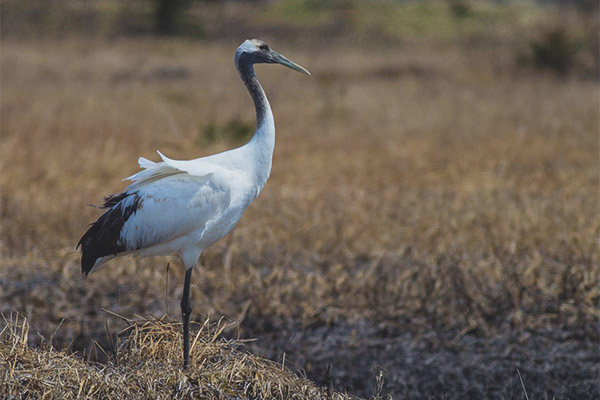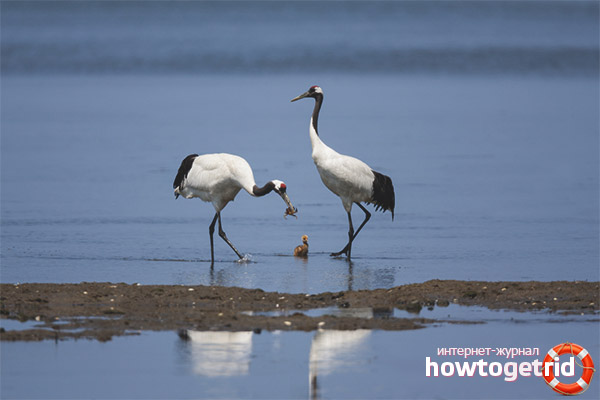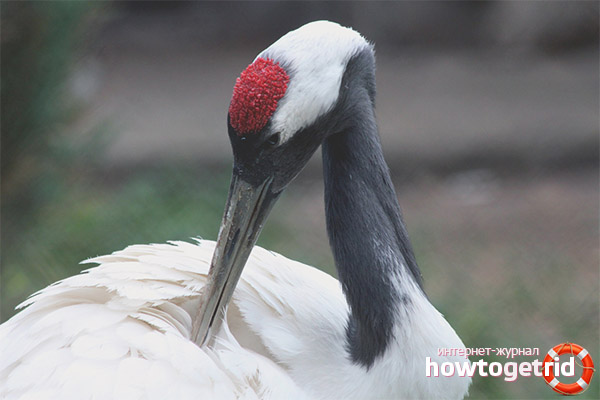The content of the article
A Japanese crane is a beautiful and majestic bird surrounded by legends. The individual of this species is whitish with black markings. Long since interest to these birds from the person does not subside. People continue to explore the species, discovering new and new aspects that affect these birds. Today we will study everything that concerns them. We give information regarding reproduction, nutrition, general lifestyle, etc.
Features of the form
- As the name implies, Japan is considered to be the country of origin of these birds. There, species of species are classified as sacred. The Japanese believe that cranes embody purity and loyalty.
- Also, local residents believe in the fulfillment of desires, all dreams can become a reality, and the goals - to be achieved. Partly for this reason, the Japanese make thousands of paper cranes and place them in their homes. Crane has long been a feathered symbol of China and Japan.
- All human values are associated with a crane. It is about prosperity, family well-being, longevity, wealth. The image of a feathered bird represents success, a person seeks to decorate his house with statues.
- Due to the fact that in terms of their natural habitat, these birds have decreased in their numbers, this makes them even more mysterious. The Japanese and other peoples of our planet are trying to preserve the species, in every possible way protecting and preserving it.
Description and habitat
- An individual of this variety is understood to be a large bird, as tall as 160 cm. As for the mass of the hull, these figures vary between 8 and 10 kg. Naturally, one cannot do without a mark of wingspan, namely 2.5 m. By feathering these birds are whitish, but dark marks can be observed on the hull.
- The neck is black, on it is decorated with an oblong line of white tone. Fly feathers in the lower part are also black, make the silhouette slim and noble. In adult-type individuals, the cap has a red color on the head. Legs are long, slim, greyish, dark. With regard to differences in gender, females are smaller than males.
- Young animals are colored differently than the older generation. When the chicks are just born, they look reddish. Over time, they change the plumage, which resembles a mixed one. In the dress there are feathers of a brownish, white, brown, gray tone. The head is covered with plumage not locally. When the younger generation matures, it puts on the outfit of adults.
- In terms of their natural habitat, these birds are common in China and Japan. They are divided into several main varieties. There are cranes of the island population, which are more often sedentary. They inhabit the Kuril Islands, as well as in Hokkaido. Prefer cold climatic regions.
- There is also a population of continental birds that are migratory by their natural features. These individuals are dispersed throughout the expanses of our country, as well as in China, Korea and Mongolia. They love warm places, so they go there for the winter.
6. It is worth mentioning separately about the national reserve zone located in China. There are many representatives of the family. On the territory of about 85 thousand square meters. km lives more than 2 thousand individuals. - These birds are declining in their population due to the human factor. Dams are being built, the environment is being polluted, the amount of undeveloped land is decreasing, agricultural land is expanding and other aspects affect the number of cranes.
Lifestyle
- Birds are most active in the daytime. They gather in flocks and go to feed. Gain food in the reed zone in the marshland.
- The life of these birds includes various rituals. They have a lot of poses, voice messages, movements that help communicate with each other and express feelings. This kind of behavior is called a crane dance, it unites birds of different age categories.
- Often, the ritual starts only one individual. Only after some time, other individuals gradually begin to join. As a result, the whole flock begins to participate in the dance. It is worth noting that many movements from such rituals were borrowed by people for folk dances.
- The considered individuals perform unusual jumps, while the birds spread their wings widely. They also rotate legs beautifully in the air.Birds perform wave-like movements, bows and tossing grass tufts. Cranes swivel beak in different directions. Thus, they show the mood and the relationship.
- In many folk traditions, the individuals in question are a symbol of health, happiness, prosperity and longevity. If you believe the legends, it is worth noting that when the crane comes close to a person, the last one will have great luck Before the lucky one opens a calm and self-sufficient life.
- In Japanese nature conservationists, the Crane symbol flaunts as an emblem on workwear. Such people try to preserve rare species of birds. To do this, they are engaged in their breeding in a special nursery. It is worth noting that cranes reproduce very poorly outside the conditions of wild nature.
- Also, the birds do not make sense to release into the wild. They are simply not ready for this. Birds will be exposed to numerous hazards. Cranes are listed in the Red Book, they disappear. All over the world, such individuals are protected. As in most cases, the population of individuals is reduced due to human factors.
Nutrition
- The daily diet of cranes can include both vegetable and animal food. Often these birds feed on aquatic creatures. They feed on clams and fish. Cranes also eat frogs, small birds and rodents, caterpillars, beetles, insects, worms, and even nest eggs.
- It is interesting to observe how cranes behave during feeding. They put their heads down and freeze. Birds are waiting for their prey as close as possible. Individuals with incredible speed grab the victim and swallow. Cranes also eat rhizomes, plant buds, grains, young shoots, etc.
Breeding
- Nesting birds begin in the spring. Often this season falls at the end of March or the beginning of April. It should be noted that cranes belong to monogamous couples. When individuals begin to reunite, they make very beautiful and complex melodic sounds. Birds merge in joint singing.
- At this time, the cranes are standing together, while their beaks are raised. The male tries to spread his wings as widely as possible. The female, on the contrary, folds them along the body. Often the nest is built in the tall grass, which is located near the water.At this time, the male begins to very carefully protect the offspring and his female.
Cranes are unique individuals that are on the verge of extinction. At the moment, the birds are protected. The cause of death of birds is human factors. Because of the burning of swamps, cranes are dying. In addition, there are many legends about the individuals in question. Such birds in captivity can live up to 80 years!
Video: Japanese Crane (Grus japonensis)













To send